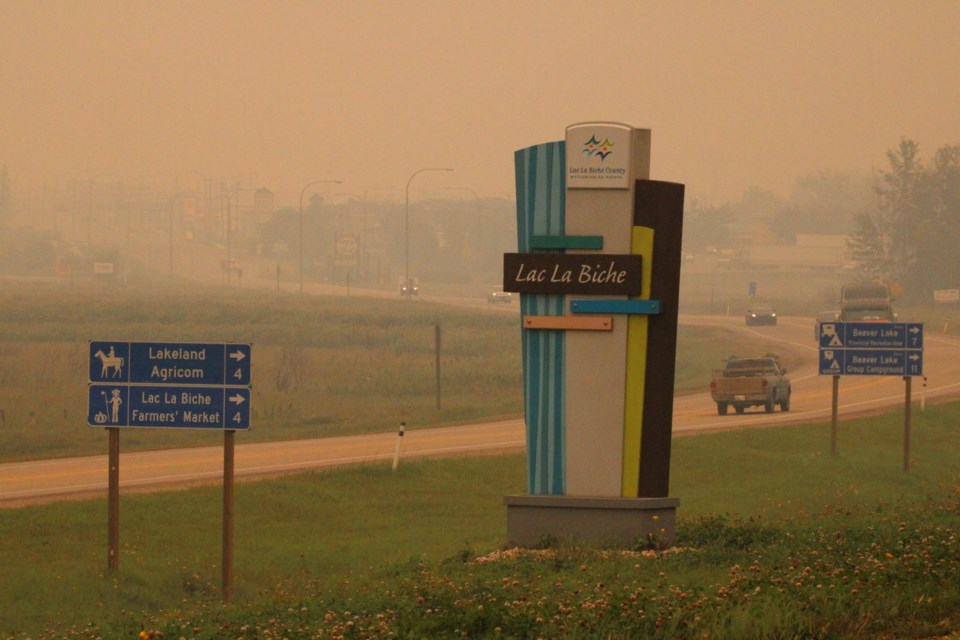LAC LA BICHE - When smoke from a historically high year of forest fire activity blankets a region, it’s not just ground level activity that are affected — it goes higher than that.
Oriana Kononchuk is president of the Lac La Biche Flying Club. She says that while the Lakeland region has been fortunate over the summer months regarding forest fires, smoke from active fires in BC and the North West Territories has been a challenge for area pilots who fly recreationally.
Over the summer months, provincial and regional statistics on air quality have hit historic numbers due to forest fire smoke.
Kononchuk, who pilots her own Cessna 172, says smoky conditions are another factor that determines whether a pilot will take to the skies. Because most small-craft pilots navigate by sight and by radio communications with other pilots — unlike commercial pilots who also have instruments, radar and air traffic control contact from larger airports — they are restricted when bad weather … or smoke... rolls in.
“Transport Canada rules state that recreational pilots must have a minimum of three miles of visibility as well as not less than 500 feet from the ground visibility in order to fly ,” she told Lakeland This Week. “On the other hand, commercial and airline pilots have fewer restrictions placed on them due to the fact that they can fly strictly with the instruments on their panels.”
Along with the safety aspects, smoke can also raise maintenance issues for local pilots.
According to Kononchuk, while smoke generally doesn’t cause a lot of damage to recreational aircraft, engine performance can be affected if ashes or small particles plug intake filters, which reduces the amount of air flow to an engine. Meanwhile, smoke has little to no effect on an aircraft’s propellor or wings.
Guiding help
While Kononchuk says a pilot would not intentionally fly into a blanket of smoke, if a recreational pilot does encounter a sudden area of smoke or a quickly developing storm, a series of navigational beacons dot the Canadian landscape that send VHF signals that pilots can use to find their bearings. Small airports, like the ones in Lac La Biche, St. Paul and Bonnyville, are also equipped with a rural area navigation system that can provide GPS coordinates and horizontal guidance to the runway.
Chris McDonnell, a manager and pilot for Delta Helicopters in Lac La Biche, says smoky skies are always viewed as a safety issue. If visibility is poor, the company’s fleet of helicopters remains grounded.
“If we can’t see, we don’t go,” he said, voicing a common mantra among all pilots. “The risk of a midair collision is too great. Under provincial and federal law, there is a one-mile visibility rule for commercial aircraft, who are also required to stay 300 feet above the ground,” the veteran pilot explained.
McDonnell said smoke in general doesn’t affect the machinery of a helicopter, especially when pilots fly at higher elevations.
“Other than engines occasionally running hotter than usual, I haven’t noticed any difference while flying,” he said. “Wildfire smoke is purely a safety issue for pilots, who always make sure they can see before heading out.”
While helicopters won’t fly directly into a blanket of smoke, they do help to reduce the fires that cause it. Helicopters are an integral part of forest firefighting efforts, carrying personnel and equipment to hard-to-reach areas, and also lifting specialized water containers called “Bambi Buckets” that can hold 5,000 to 10,000 litres of water depending on the size of the helicopter. The buckets are carried under the helicopters and can be ‘dipped’ into available water sources near fires, and then dropped onto the flames. Since April of this year, Delta Helicopters and other companies have been assisting in the ongoing battle against wildfires throughout Alberta, BC, and the Northwest Territories.
Recent hazy skies over the Lakeland region are the result of the ongoing battle against massive fires still burning in the Northwest Territories and parts of British Columbia. Although an evacuation order has been removed for many areas of the Territories, there are still 150 active fires. So far this year, 300 fires contributed to a total burn area of 3.5 million hectares of land in the North.
In BC, forest fire officials this week are reporting that more than 400 fires remain active around the province. Fires in BC in 2023 have burned more than 2.4 million hectares.



